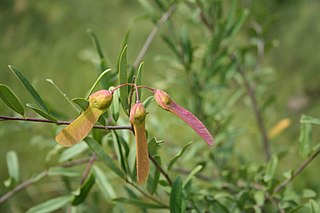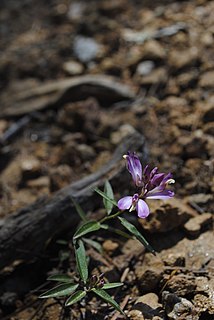
The Fabales are an order of flowering plants included in the rosid group of the eudicots in the Angiosperm Phylogeny Group II classification system. In the APG II circumscription, this order includes the families Fabaceae or legumes, Quillajaceae, Polygalaceae or milkworts, and Surianaceae. Under the Cronquist system and some other plant classification systems, the order Fabales contains only the family Fabaceae. In the classification system of Dahlgren the Fabales were in the superorder Fabiflorae with three families corresponding to the subfamilies of Fabaceae in APG II. The other families treated in the Fabales by the APG II classification were placed in separate orders by Cronquist, the Polygalaceae within its own order, the Polygalales, and the Quillajaceae and Surianaceae within the Rosales.

Cercis is a genus of about 10 species in the subfamily Cercidoideae of the pea family Fabaceae, native to warm temperate regions. It contains small deciduous trees or large shrubs commonly known as redbuds. They are characterised by simple, rounded to heart-shaped leaves and pinkish-red flowers borne in the early spring on bare leafless shoots, on both branches and trunk ("cauliflory"). Cercis is derived from the Greek word κερκις (kerkis) meaning "weaver's shuttle", which was applied by Theophrastus to C. siliquastrum.

Helianthus is a genus comprising about 70 species of annual and perennial flowering plants in the daisy family Asteraceae. Except for three South American species, the species of Helianthus are native to North America and Central America. The common names "sunflower" and "common sunflower" typically refer to the popular annual species Helianthus annuus, whose round flower heads in combination with the ligules look like the sun. This and other species, notably Jerusalem artichoke, are cultivated in temperate regions and some tropical regions as food crops for humans, cattle, and poultry, and as ornamental plants. The species H. annuus typically grows during the summer and into early fall, with the peak growth season being mid-summer.

Ageratum is a genus of 40 to 60 tropical and warm temperate flowering annuals and perennials from the family Asteraceae, tribe Eupatorieae. Most species are native to Central America and Mexico but four are native to the United States.

The Polygalaceae or the milkwort family are made up of flowering plants in the order Fabales. They have a near-cosmopolitan range, with about 21 genera and ca. 900 known species of herbs, shrubs and trees. Over half of the species are in one genus, Polygala, the milkworts.

Polygala is a large genus of flowering plants belonging to the family Polygalaceae. They are commonly known as milkworts or snakeroots. The genus is distributed widely throughout much of the world in temperate zones and the tropics. The genus name Polygala comes from the ancient Greek "much milk", as the plant was thought to increase milk yields in cattle.

Polygaloides paucifolia, synonym Polygala paucifolia, known as gaywings or fringed polygala, is a perennial plant of the family Polygalaceae.

Polygaloides chamaebuxus, synonym Polygala chamaebuxus, the shrubby milkwort, is an ornamental plant in the family Polygalaceae. Its flowers are solitary or in pairs in the leaf axils. The inner two sepals, the wings, are upright and white to yellow, sometimes pinkish or purple. The keel petals are bright yellow, aging to brownish-red or purple. It is native to the Alps and the mountains of west-central Europe. It was known to be grown in cultivation in about 1658 and was illustrated by Carolus Clusius. It has been given the Royal Horticultural Society's Award of Garden Merit.

Comesperma is a genus of shrubs, herbs and lianas in the family Polygalaceae. The genus is endemic to Australia. It was defined by the French botanist Jacques Labillardière in his 1806 work Novae Hollandiae Plantarum Specimen. The genus name is derived from the Ancient Greek words come ("hair") and sperma ("seed"), and relates to the seeds bearing tufts of hair. The genus is distributed over southern Australia, particularly in the southwest of Western Australia, where 19 species are found. 24 species have been described.

Rhinotropis acanthoclada, synonym Polygala acanthoclada, is a species of flowering plant in the milkwort family known by the common names desert polygala and thorn milkwort. It is native to the desert woodlands of the southwestern United States from Utah to the Mojave Desert. It is a small, bushy shrub spreading or growing erect and approaching one meter in maximum height. It is hairy in texture, the youngest twigs hairiest with a feltlike coat of short, whitish fibers. The lance-shaped or oval leaves are up to 2.5 centimeters long. Some of the twigs narrow to spines at the tips, especially in the inflorescences. The flowers are solitary or in clusters of up to 15. Each flower has five sepals, the lateral two white in color and spreading out like wings. The middle petal is keeled, with a flat tip protruding. The fruit is a capsule about half a centimeter long.

Rhinotropis californica, synonym Polygala californica, is a species of flowering plant in the milkwort family known by the common name California milkwort. It is native to southwestern Oregon and northern and central California, where it grows in the coastal mountain ranges in local habitat types such as chaparral and forest. It is a perennial herb producing spreading stems, generally decumbent in form, up to about 35 centimeters in maximum length, lined with narrow oval leaves each a few centimeter long. The upper inflorescences produce several open flowers, and there may be some closed, cleistogamous flowers lower on the plant. The open flowers have pink or white winglike lateral sepals with hairy edges. The petals are similar in color, the central one tipped with a white or yellow beak. The fruit is a flattened green capsule up to a centimeter long containing hairy seeds.
Rhinotropis heterorhyncha, synonym Polygala heterorhyncha, is a species of flowering plant in the milkwort family known by the common names beaked spiny polygala and notch-beaked milkwort. It is native to southern Nevada and it is known from a few occurrences just over the border in the Funeral Mountains of California above Death Valley. It is a resident of desert scrub habitat. This desert plant is a perennial herb or small shrub growing in small clumpy mats. The thin, branching, thorny-tipped stems are somewhat waxy in texture and sometimes slightly hairy. They are lined sparsely with small oval, dull-pointed leaves. The inflorescence bears a few flowers, each with a winglike pair of bright pink sepals and a yellow-tipped central petal. The fruit is a vein-streaked capsule.

Polygala myrtifolia, the myrtle-leaf milkwort, is an evergreen 2-4m tall South African shrub or small tree found along the southern and south-eastern coasts, from near Clanwilliam in the Western Cape to KwaZulu-Natal. It is a fast-growing pioneer plant, a typical fynbos component, and may be found on dunes, rocky places, along forest margins, beside streams, and in open grassland. It belongs to the milkwort family of Polygalaceae.

Hebecarpa macradenia, synonym Polygala macradenia, the glandleaf milkwort, is a subshrub in the milkwort family (Polygalaceae) found in the Arizona Uplands of the Sonoran Desert. Its "odd" flowers are said to be "spectacularly beautiful" when viewed with a hand lens.
Brickellia hebecarpa is a Mexican species of flowering plants in the daisy family. It is native to western Mexico, the states of Colima, Michoacán, and Jalisco.

Polygala lutea, commonly known as orange- or yellow milkwort, is a plant in the milkwort family (Polygalaceae) native to pine-barren depressions and swamps in costal areas of the southern and eastern the United States. It was first described in 1753 by Carl Linnaeus.

Polygala alba, commonly called white milkwort, is a species of flowering plant in the milkwort family (Polygalaceae). It is native to North America, where it is found in Canada, Mexico, and the United States. In the United States, its range is concentrated in the Great Plains and the Southwest. Its natural habitat is in rocky or sandy dry prairies.

Rhinotropis is a small genus in the family Polygalaceae. It was separated as a genus from Polygala by J. Richard Abbott in 2011. It is native to the south and west of the United States and to Mexico.

Hebecarpa is a genus of flowering plants belonging to the family Polygalaceae. Species are found from the southern United States through Mexico and Central America to western South America.
Polygala multiflora is a plant species in the milkwort family (Polygalaceae). It is native to Western Africa. It is an erect plant and is considered to be "probably 2 to 3 feet " though it can grow up to 6 feet (1.8 m) tall. Its stems are puberlouous and its leaves are 2 to 3 inches long and 1⁄6 inch (0.42 cm) wide. The flowers it produces are blue or purple. It was first written about was part of the Encyclopédie méthodique Botanique in 1804 by Jean Louis Marie Poiret.















